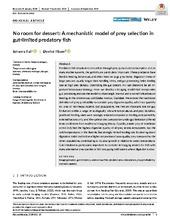| dc.contributor.author | Fall, Johanna | |
| dc.contributor.author | Fiksen, Øyvind | |
| dc.date.accessioned | 2020-08-10T08:25:16Z | |
| dc.date.available | 2020-08-10T08:25:16Z | |
| dc.date.issued | 2020 | |
| dc.Published | Fall JJE, Fiksen Ø. No room for dessert: A mechanistic model of prey selection in gut-limited predatory fish. Fish and Fisheries. 2020;21(1):63-79 | eng |
| dc.identifier.issn | 1467-2960 | en_US |
| dc.identifier.issn | 1467-2979 | en_US |
| dc.identifier.uri | https://hdl.handle.net/1956/23598 | |
| dc.description.abstract | Predatory fish structure communities through prey pursuit and consumption and, in many marine systems, the gadoids are particularly important. These predators have flexible feeding behaviours and often feed on large prey items. Digestion times of large prey are usually longer than handling times, and gut processing limits feeding rate at high prey density. Optimizing the gut content mix can therefore be an important behavioural strategy. Here, we develop a foraging model that incorporates gut processing and use the model to disentangle internal and external limitations on feeding in the omnivorous cod (Gadus morhua , Gadidae). We extend the traditional definition of prey profitability to consider prey digestive quality, which we quantify for prey of Northeast Atlantic cod populations. We find an important role for gut limitation; within a range of ecologically relevant temperatures and prey densities, predicted feeding rates were strongly reduced compared to feeding constrained by external factors only, and the optimal diet composition under gut limitation differed from predictions from traditional foraging theory. Capelin, a main prey of Northeast Arctic cod, had the highest digestive quality of all prey across ecosystems, but the cold temperatures in the Barents Sea strongly limited feeding rate by slowing down digestion. Baltic cod fed on a higher proportion of poor‐quality prey compared to the other populations, contributing to its slow growth in relation to water temperature. Gut limitation is particularly important to consider in foraging models for fish with many alternative prey species or fish occupying cold waters where digestion is slow. | en_US |
| dc.language.iso | eng | eng |
| dc.publisher | Wiley | en_US |
| dc.rights | Attribution CC BY | eng |
| dc.rights.uri | http://creativecommons.org/licenses/by/4.0 | eng |
| dc.title | No room for dessert: A mechanistic model of prey selection in gut-limited predatory fish | en_US |
| dc.type | Peer reviewed | |
| dc.type | Journal article | |
| dc.date.updated | 2019-12-17T12:35:38Z | |
| dc.description.version | publishedVersion | en_US |
| dc.rights.holder | Copyright 2019 The Author(s) | en_US |
| dc.identifier.doi | https://doi.org/10.1111/faf.12415 | |
| dc.identifier.cristin | 1760038 | |
| dc.source.journal | Fish and Fisheries | |
| dc.relation.project | Norges forskningsråd: 255460 | |
| dc.relation.project | Norges forskningsråd: 243676 | |
| dc.identifier.citation | Fish and Fisheries. 2020, 21 (1), 63-79. | |

